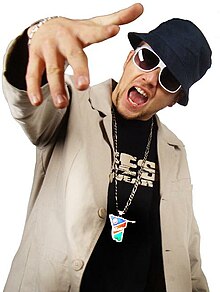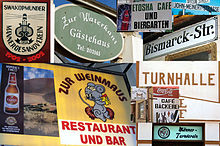German Namibian
The term Deutschnamibier describes the German citizens of the South West African Republic of Namibia . To distinguish themselves from the other ethnic or linguistic groups in the country, they often only refer to themselves as Germans ; in contrast, they refer to Germans from Germany as "German nationals". Sometimes they still refer to themselves as Südwester or Südwesterdeutsche , with reference to the German colony Deutsch-Südwestafrika, which existed from 1884 to 1915 . Many German Namibians already live there in the fifth generation and have both Namibian and German citizenship . From the perspective of German law, they can therefore be referred to as Germans abroad .
background
In 2011, around 20,000 Namibians stated German as their mother tongue, although it is difficult to statistically establish whether an ethnic affiliation among the roughly 100,000 white Namibians or a linguistic affiliation - especially Afrikaans and English - is mixed . The German-Namibian population is distributed across all parts of the country with the exception of the communal areas as well as the far north and Caprivi . In the cities of Windhoek and Swakopmund , among others, German is an important lingua franca alongside Afrikaans and the official language, English. In addition to the language, a nationwide influence of the German Namibians remains lively, especially in the food and festival culture, clubs and economic structure.
In a broader sense, the approximately 400 black " GDR children of Namibia " who grew up in the GDR and were deported to Namibia after 1990 can also be counted among the German-Namibians (in the sense of "German-speaking Namibians"); Otherwise, however, they have little in common with the descendants of the German colonists.
The German Cultural Council is regarded as the cultural interest group in Namibia . Other interest groups are the discussion group of German-speaking Namibians , which was founded in Swakopmund at the beginning of 2019, as well as a new association announced in August 2019 that is supposed to represent all the interests of the German -speaking Namibians .
Culture
Many place names and buildings from the imperial German colonial era still shape the image of many Namibian cities and landscapes, e.g. B. the four Sander castles ( Heinitz- , Schwerins- and Sanderburg in Windhoek as well as Duwisib Castle near Maltahöhe - named after their architect Wilhelm Sander ), the Hohenzollernhaus, the district office and the "old district court" in Swakopmund and the Goerke house in Luderitz . The numerous military buildings from that time such as For example, the " Alte Feste " in Windhoek, the pioneer barracks and the military hospital in Swakopmund , as well as the forts of Sesfontein and Namutoni ( Etosha ) and numerous train station buildings throughout Namibia.
There is also a very active club life in Namibia, the roots of which go back to the German colonial era. In Windhoek, the Windhoek Carnival (WIKA), which is based on the Cologne and Mainz models, and the Oktoberfest are major city festivals.
An independent German-Namibian literature has developed since the early 20th century . A well-known author in Germany was Giselher W. Hoffmann .
The NamSA (Namibia-South Africa Festival) has been organized by the German Namibian Youth for several decades . It is a festival of Deutschnamibier in Germany, Austria and Switzerland .
History of German settlement
The first Germans in Namibia were the missionaries of the London Missionary Society , Wesleyan Methodist Missionary Society and later the Rheinische Missionsgesellschaft . The institutions worked closely together at the end of the 18th century, as the Rhenish Mission did not yet have its own mission institutions in southern Africa. So it was among others the brothers Christian and Abraham Albrecht and after them the missionaries Johann Hinrich Schmelen , Johann Rath, Franz Heinrich Kleinschmidt , Hugo Hahn , Peter Heinrich Brincker and Heinrich Vedder , who settled religiously in South West Africa for several decades since 1805 Provided instruction, but also preparatory work for the later colonization.
The Rheinische Missionsgesellschaft had set up a large network of individual mission institutions in the region. Their missionaries gained considerable influence, were given a special diplomatic status after the establishment of colonial rule, and increasingly played a political role. As a result, they also became a reserve system for the German military administration to control the unsettled, regional groups of indigenous inhabitants of the country. In addition, through the educational and economic groundwork among the indigenous peoples, they became increasingly important.
They were followed by traders and, after the landing of the barque “Tilly” in Lüderitz Bay in 1883, more and more German officials, settlers, craftsmen and soldiers. After the area was officially declared a colony of German South West Africa in 1884 and also recognized by England, an ever increasing migration from Germany began, which culminated in 1908 with the first diamond discoveries near Lüderitz .
This development stagnated after the end of the First World War, as a result of which Germany withdrew all claims to its colonies by the Treaty of Versailles and South Africa was given mandate administration over German South West Africa by the League of Nations . In the course of the subsequent "South Africanization" of the former colony, around half of the 15,000 Germans still living there were expelled and their farms were transferred to South Africans. South Africa's policy, known as “de-Germanization”, only changed with the London Agreement of October 23, 1923, according to which the Germans remaining in the country were offered British citizenship and immigration from Germany and the expansion of the German language were strongly encouraged. Around 3,200 Germans made use of the option to change their citizenship.
The relationship between the Germans and Boer residents of South West Africa was again strained in 1927 by the arrival of the last 1,800 Dorsland trekkers returning from Angola . The British-dominated South Africa did not attach great importance to their return to the territory of the South African Union and therefore supported the wish of the Dorsland trekkers to want to stay in South West Africa, especially since they had already found a benevolent reception there at the turn of the century while fleeing the English. In 1927, however, the joy of the German-born farmers about these "returnees" was rather subdued, as they saw their settlement - certainly not entirely wrongly - as a further step in the effort to "degrade" South West Africa to the fifth province of South Africa. Against this background and in view of the dramatic consequences of the global economic crisis, which were also noticeable in South West Africa (approx. 70-80% of the livestock was lost), the "national movement" imported from Germany had an easy time of it: in 1932 the South West African branch of the NSDAP with offices throughout Land established. This party had a similarly large influx among the Germans as in Germany, so that the South African mandate administration felt compelled to ban the party again in 1934.
With the beginning of the Second World War , the South African Union sided with the British with a narrow majority. The residents of German descent living in South West Africa were first placed under farm or house arrest in 1939 and then taken to internment camps in South Africa from 1940, where they had to remain until 1946. From 1942 the British citizenships granted in 1923 were revoked.
The apartheid policy pursued from South Africa in its special form according to the Odendaal Plan was met with increasing criticism from many states and the UN and at the same time resulted in the emergence and strengthening of a black resistance movement - also in South West Africa. The relationship between the South African mandate administration and the population of German descent improved to the same extent, so that the increased immigration from Germany that was observed after the Second World War was viewed favorably.
Most of the German Namibians living in Namibia today are descendants of farmers, officials of the colonial administration, craftsmen and members of the protection force as well as of the two waves of immigration that began after the world wars. Since around 1980, increasing tourism has led to more land and real estate acquisitions by Germans who intended to set up a permanent holiday home or retirement home here.

Well-known German Namibians
- Gaby Ahrens (* 1981), sports shooter
- Beate Baumgartner (* 1983), singer
- Rudolf Bester (* 1983), football player
- Monica Dahl (* 1975), swimmer
- Klaus Dierks (1936–2005), traffic planner
- Björn von Finckenstein (* 1958), doctor and politician
- Rolf von Goth (1906–1981), actor and radio play director
- Wilfried Hähner (* 1973), journalist and radio host
- Otto Herrigel (1937–2013), lawyer and politician
- Giselher W. Hoffmann (1958-2016), writer
- Erik Hoffmann (* 1981), cyclist
- Adolph Jentsch (1888–1977), cyclist
- Helmut Lewin (1899–1963), portrait and landscape painter
- Jörg Lindemeier (* 1968), swimmer
- Anton Lubowski (1952–1989), lawyer and political activist
- Oliver Risser (* 1980), soccer player
- Wilko Risser (* 1982), soccer player
- Imke Rust (* 1975), artist
- Friedhelm Sack (* 1956), marksman
- Calle Schlettwein (* 1954), politician
- Eric Sell (born 1983), musician
- Manfred Starke (* 1991), soccer player
- Sandra Starke (* 1993), soccer player
- Anton von Wietersheim (* 1951), politician
- Hellmut von Leipzig (1921–2016), soldier in World War II
literature
- Martin Eberhardt: Between National Socialism and Apartheid. The German population group of South West Africa 1915-1965 ( Periplus studies 10). LIT Verlag, Berlin et al. 2007, ISBN 978-3-8258-0225-7 .
- Lucia Engombe, Peter Hilliges: Child No. 95. My German-African Odyssey . Ullstein, Berlin 2004, ISBN 3-548-25892-1 .
- Constance Kenna (Ed.): The "GDR Children" of Namibia. Returnees to a foreign country . Klaus Hess Verlag, Göttingen / Windhoek 1999, ISBN 3-933117-11-9 .
- Walter G. Wentenschuh: Namibia and its Germans. History and present of the German language group in southwest Africa ( Edition Namibia 1). Klaus Hess Verlag, Göttingen 1995, ISBN 3-9804518-0-1 .
- Joachim Born, Sylvia Dickgießer: German-speaking minorities. An overview of the state of research for 27 countries. On behalf of the Foreign Office, ed. from the Institute for the German Language. Mannheim 1989, ISBN 3-922641-39-3 .
Web links
- The "GDR Children of Namibia"
- General Newspaper Windhoek
- German-Namibian Society eV dngev.de
- Web portal of Deutschnamibier abroad, especially Europe / Germany
Individual evidence
- ↑ Namibia Population & Housing Census 2011. Namibia Statistics Agency , March 2013
- ↑ Discussion group founded. Allgemeine Zeitung, April 8, 2019.
- ↑ A balancing act of interests. Allgemeine Zeitung, August 9, 2019.
- ↑ Official website of the WIKA
- ↑ NAMSA - Feast of Deutschnamibier in Europe
- ^ André du Pisani : SWA / Namibia: The Politics of Continuity and Change . Johannesburg, 1986, pp. 14-15
- ^ André du Pisani: SWA / Namibia: The Politics of Continuity and Change . Johannesburg, 1986, pp. 15-16


